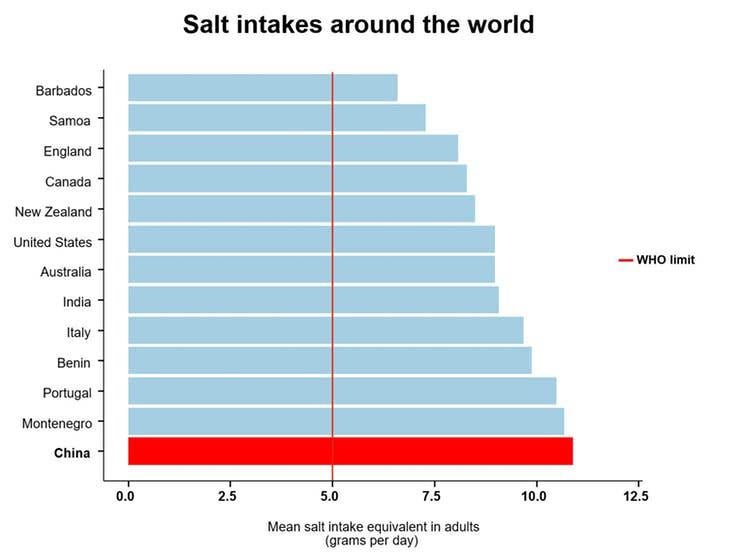Against the grain: How can China kick its deadly salt habit?
Country’s average intake among adults is well above the maximum recommendation set by the UN

Your support helps us to tell the story
From reproductive rights to climate change to Big Tech, The Independent is on the ground when the story is developing. Whether it's investigating the financials of Elon Musk's pro-Trump PAC or producing our latest documentary, 'The A Word', which shines a light on the American women fighting for reproductive rights, we know how important it is to parse out the facts from the messaging.
At such a critical moment in US history, we need reporters on the ground. Your donation allows us to keep sending journalists to speak to both sides of the story.
The Independent is trusted by Americans across the entire political spectrum. And unlike many other quality news outlets, we choose not to lock Americans out of our reporting and analysis with paywalls. We believe quality journalism should be available to everyone, paid for by those who can afford it.
Your support makes all the difference.People in China have used salt to prepare and preserve food for thousands of years. But consuming lots of salt raises blood pressure, increasing the risk of cardiovascular disease. Cardiovascular disease, which includes heart attack and stroke, now accounts for 40 per cent of deaths in China.
It is well known that salt consumption in China is high, but accurate assessments are scarce. Public health experts need robust estimates of salt intake to help them develop strategies to reduce this intake. An example of a promising strategy is replacing regular salt with potassium salt, which contains less sodium (which raises blood pressure) and more potassium (which lowers blood pressure).
The most accurate way to measure salt intake is to measure the sodium excreted in urine over a 24-hour period. Although this data was collected in China, it has never been comprehensively reviewed. Our latest review, published in the Journal of the American Heart Association, aimed to plug this knowledge gap.
Searching both English and Chinese-language databases for all studies ever published that reported 24-hour urinary excretion of either sodium or potassium in China, we found 70 with sodium data (drawn from 26,767 participants), of which 59 also reported potassium data (drawn from 24,738 participants). The data covered four decades and most provinces of China.
Of all the reviews of salt intake in China, our review is the first to be systematic and is by far the largest.
High salt and low potassium intakes
Our meta-analysis of the combined data revealed important patterns in salt and potassium consumption in China. We found, for example, that on average children and adolescents exceed the salt-intake limit set for adults.
The World Health Organisation (WHO) recommends adults consume less than 5g of salt per day, and this upper limit should be reduced for children and adolescents according to their energy requirements. In China, however, children aged three to six, on average, consume 5g of salt per day. The WHO recommendation was far exceeded by children and adolescents aged six to 16 years. Their intake averaged a worrying 8.7g per day.
In adults, the average salt intake was 10.9g per day, which is more than twice the maximum recommendation set by the WHO and one of the highest salt intakes in the world.

Our review also showed geographical differences between northern and southern China. Salt intake in northern China has declined over the past four decades, which may be the result of the government’s efforts to increase salt awareness and of improvements in the year-round availability of fresh produce. Yet, despite this decline, the average salt intake in northern Chinese adults remains high, at 11.2g per day.
In contrast, salt intake in southern China has increased during that same period, which could be due to increased consumption of processed, restaurant and takeaway foods, which are typically high in salt.
Finally, we also found that potassium intake was less than half the recommendation. Potassium intake has been consistently low throughout China for the past 40 years, with people in all age groups consuming less than half the recommended minimum intakes.
Improving matters
With a fifth of the world’s population living in China, reducing salt and increasing potassium intakes across the country would be of enormous benefit for global health. Here is how to achieve this:
- Replace regular salt with potassium salt. Unlike in western countries, where most of the salt comes from processed foods, most salt consumed in China comes from the salt added while cooking. Potassium salt can be used the same way as regular salt and would have the added benefit of increasing people’s potassium intake.
- Start early in life. Childhood and adolescence are when dietary habits and taste preferences are formed. If a child eats more salt, they will develop the taste for salt and are more likely to eat more salt as an adult. Also, high blood pressure in childhood tracks into adulthood.
- Anticipate new sources of salt intake. There is a rapid increase in the consumption of processed foods and of food from street markets, restaurants and fast-food chains in China. Setting maximum targets for their salt content would create a level playing field where salt is reduced across the board, which would help guide the population in getting used to a less salty taste.
Monique Tan is a PhD researcher at Queen Mary University of London. This article first appeared on The Conversation
Subscribe to Independent Premium to bookmark this article
Want to bookmark your favourite articles and stories to read or reference later? Start your Independent Premium subscription today.
Join our commenting forum
Join thought-provoking conversations, follow other Independent readers and see their replies
Comments